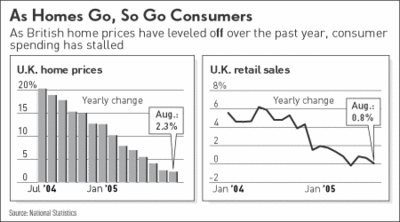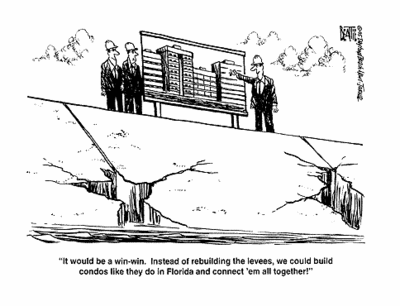By Russ Britt, MarketWatch
Last Update: 5:43 PM ET Aug 26, 2005
BAKERSFIELD, Calif. (MarketWatch) -- Visalia. Merced. Fresno. Bakersfield.
These dusty centers of California's San Joaquin Valley epitomize the newest and, in many cases, surprising players in America's red-hot real-estate craze. Until now, most of them have sat on the sidelines while places like Los Angeles and New York racked up higher prices. Along the way, experts have identified these places as prime examples of inflated markets that carry significant risk of bursting their bubbles.
And this new real estate gold rush has spread east to Nevada and south to Arizona. Las Vegas, Reno, Phoenix and even tiny Prescott, Ariz., all are sharing in the wealth. Farther east, a number of cities in Florida are seeing their values catapult in sort of a rolling bull market where various regions take turns at the top of the heap.
It's all leaving experts to wonder when the massive price hikes will start to let up.
"My theory is it has become the investment du jour," said Jay Butler, director of Arizona State University's Real Estate Center.
One key is whether these new players will have the staying power if and when a downturn comes along. For many, the worst scenario is prices will level off as long as interest rates don't jump and easy loans like interest-only mortgages don't come back to bite buyers.
But there is also fear that personal-income levels won't be strong enough to support rapidly rising prices.
"I think right now we're in more for a moderation of the process," Butler said.
Florida, Arizona and Nevada -- along with California -- comprised four of the nation's top seven states in house price appreciation during the first quarter, according to the Office of Federal Housing Enterprise Oversight.
Topping the list was Nevada, which includes the white-hot Las Vegas-area market.
It's expected those four states will remain among the top seven when second-quarter figures are released, though there could be some reshuffling.
Figures from Fannie Mae show Arizona topping the list for the second quarter, with Florida in third, Nevada sixth and California seventh. U.S. housing oversight agency figures are based in part on Fannie and Freddie data.
High inventory in Florida
Inventory, however, may be the undoing of such communities such as Naples, Fla., an upscale city on the state's southern Gulf Coast. The number of existing home listings on Realtor.com for Naples stands at roughly 3,300 single-family homes and condominiums - 600 more than Phoenix.
But Naples has only 21,000 total housing units, less than 4% that of Phoenix. That leaves Naples with more than 15% inventory in existing homes -- and that doesn't include new home sales. Prices in the Naples area jumped 23.6% from March 2004 to March 2005, placing it 25th on the federal data list.
While Naples is high in inventory, it reflects what's going on in the rest of Florida. The West Palm Beach-Boca Raton-Boynton Beach metropolitan area, for example, placed 15th on the home-price appreciation list, rising 25.8% during the first quarter. But the existing home inventory in West Palm Beach stands at about 10%.
And even though it was ravaged by Hurricane Charley last year, Punta Gorda ranked 21st with a 24.3% price hike. Yet its inventory is just below the double-digit level at 9%.
In Naples and the rest of Collier County, prices have jumped to $500,000, said Mike Timmerman, Florida managing director for consultant Hanley Wood Market Intelligence. That's put the Naples market far ahead of other Gulf Coast cities.
But job creation, while brisk, has mostly been in service industries, he added.
"Our jobs have increased at a healthy rate of 7 to 10%, but the income is not nearly enough to support $500,000 homes," Timmerman said.
Half bought on spec?
Timmerman estimates more than half the listings now on the market in Naples are real estate speculators "flipping" properties -- buying properties and immediately putting them back on the market.
"I have some real concerns in the marketplace with the number of speculators there," he said.
One-third of the Naples listings seek $1 million or more and all are considered waterfront properties. In addition to being on the Gulf of Mexico, Naples is pockmarked with dozens of bays, inlets, estuaries, lakes and ponds.
Woody Hanson, past president of the Appraisal Institute who now runs an appraisal service in nearby Fort Myers, said Naples has overtaken Palm Beach for the highest median home prices in the state.
"It could be evidence to me that the speculators are at the end of the cycle," Hanson said. "No matter how much money you make, it can't go on forever."
One saving grace for home prices in Naples and the rest of the Florida market is there is little land available for development. As Gulf Coast cities expand to the east and Atlantic Coast cities grow west, they're beginning to touch the swamplands in the Florida peninsula's central region.
Adjacent to Naples on the east is the Big Cypress National Preserve, and next to that are the Everglades.
"There is no more there," said Barry Diskin, a Florida State University business professor specializing in real estate.
But there also are signs of cooling off. Timmerman said pricing in Naples already is beginning to soften to the point where median prices may actually dip next year.
The frantic atmosphere in home sales is cooling as well, Timmerman said. Properties are staying on the market longer and there is little bidding for homes.
"We're beginning to see the pricing escalation soften," he added.
Watching Las Vegas
For some time, the strongest price growth has been in Las Vegas, where real-estate watchers are on the edge of their seats.
The federal housing oversight survey had ranked Las Vegas second among all markets during the first quarter, with gains of 33.3% compared with the first quarter of 2004.
Land speculators in the gambling capital contributed to record price gains in recent years, many of them buying new homes and "flipping" them, or putting them back up for sale for a quick profit, despite homebuilder covenants designed to prevent that.
There now may be a few fissures forming in the Las Vegas market. Some homebuilders reportedly have cut prices by as much as 20% to ward off speculators.
Of rising concern is that on Realtor.com, there are more than 11,400 single-family homes and condos up for sale, and about 200,000 total housing units in the city, putting the inventory at more than 5%. While that ratio is common in Florida, inventory for other western cities hovers around 1%.
"People are still moving to Las Vegas to buy a new house. Old houses are moving kind of slowly," said Thomas Carroll, an economist at the University of Nevada, Las Vegas.
Even more troubling is the way buyers are acquiring houses through interest-free loans, Carroll added.
"I think that the biggest problem is people are speculating and putting zero equity into their houses," he said.
The trump card in the Las Vegas market is the federal government, which owns 80% of the state's land but steadily has ceded it to private interests, Carroll said. At any moment, large parcels could be thrown on to the market, thus diluting the value of other properties.
Foreclosures.com recently reported that residential foreclosures in the city were up 37% in June.
For the second quarter, it appears Las Vegas will slip in the price appreciation standings although its gains will remain substantial. Fannie Mae statistics show home prices in Las Vegas were up 23.5% in the second quarter, dropping it out of the top 10.
The National Association of Realtors earlier this month estimated that Las Vegas's second-quarter price appreciation was 12%, less than a fourth of what it was a year ago.
Phoenix rises
Assuming Las Vegas's mantle of fastest-growing home prices for a major city could well be Phoenix - and it may be the new hotspot for growth.
Fannie Mae stats show the Arizona capital, along with suburbs Mesa and Scottsdale, saw prices jump 37% year-to-year during the second quarter, putting it third among all U.S. metro markets, behind Bakersfield and Palm Bay, Fla.
Another source, the National Association of Realtors, says the Phoenix market rose 47% on average during the second quarter, making it first in the nation.
Up to now, Phoenix has been fairly moderate in terms of price appreciation. U.S. stats show the Phoenix-Mesa-Scottsdale area rose 20% from March 2004 to March 2005. Over the past five years, prices are up 51%.
While there are concerns the vast desert around Phoenix is ripe for development, thus creating oversupply issues, there are limitations, said Arizona State University's Butler. For one, water supplies aren't infinite.
"We have a lot of land, but it's coming at a heavy price," Butler said. As a result, Phoenix is trying to fill in pockets of vacant land - in some cases with "urban condos" that command $300,000 for 800 square feet.
That seems to matter little, says Richard Olson, a real estate developer who is constructing a community of townhomes near downtown Phoenix.
"Price has nothing to do with it. People want to know two things - how much down and how much a month," Olson said. "People are buying as much house as they can afford."
Phoenix's inventory is remarkably low, considering the area's size. In Phoenix alone, there are 2,700 single-family homes and condos on the market, according to Realtor.com, but around 500,000 total housing units in the city. That puts the available housing inventory rate at around a half percentage point.
But Olson estimates there are roughly 60,000 homes under construction in and around the city now. He doesn't see that deterring buyers at all.
"It's going to be strictly a function of interest rates," Olson said.
Listings as a percentage of total housing units
| State/City | Total housing units* | No. of listings** | % |
| CALIFORNIA | | | |
| Bakersfield*** | 115,000 | 966 | 0.84 |
| Visalia | 32,654 | 235 | 0.72 |
| Stockton | 82,042 | 1,033 | 1.3 |
| Merced | 21,532 | 217 | 1.0 |
| Fresno | 149,025 | 766 | 0.51 |
| Yuba City | 13,912 | 242 | 1.7 |
| Modesto | 67,179 | 779 | 1.2 |
| Sacramento | 163,957 | 2,779 | 1. |
| FLORIDA | | | |
| Naples | 16,690 | 3,115 | 18.7 |
| West Palm Beach | 34,769 | 3,391 | 9.8 |
| Punta Gorda | 8,907 | 875 | 9.8 |
| Sarasota | 26,898 | 1,424 | 5.3 |
| Port St. Lucie | 36,785 | 1,875 | 5.1 |
| ARIZONA | | | |
| Phoenix | 495,832 | 2,317 | 0.47 |
| Tucson | 209,609 | 1,287 | 0.61 |
| Flagstaff | 21,396 | 298 | 1.4 |
| Prescott | 17,144 | 421 | 2.5 |
| NEVADA | | | |
| Las Vegas | 190,724 | 11,222 | 5.9 |
| Reno | 79,453 | 1,575 | 2.0 |
* Figures from 2000 U.S. Census and do not include housing units built since then. ** Listings of existing homes on Realtor.com for week ending July 22. ***Bakersfield figures compiled from local realty-agency statistics.
















 Blogroll Me!
Blogroll Me!